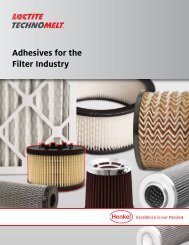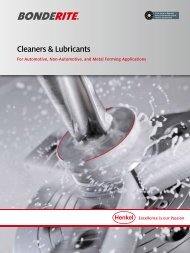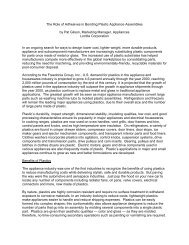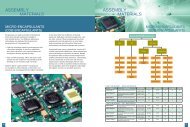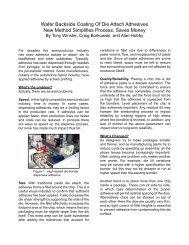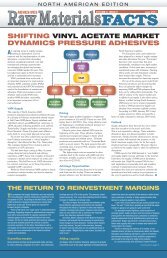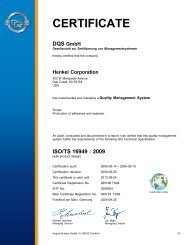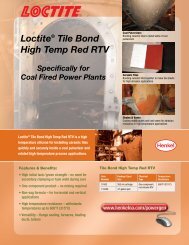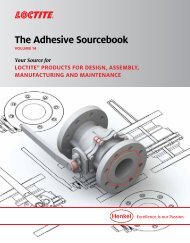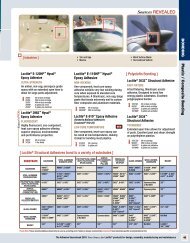Hysol® Surface Preparation Guide
Hysol® Surface Preparation Guide
Hysol® Surface Preparation Guide
Create successful ePaper yourself
Turn your PDF publications into a flip-book with our unique Google optimized e-Paper software.
Hysol <strong>Surface</strong> <strong>Preparation</strong> <strong>Guide</strong><br />
Henkel Corporation<br />
Aerospace Group<br />
Page 8 of 11<br />
Metals – cont.<br />
Adherend<br />
Material<br />
Titanium and<br />
Alloys (cont.)<br />
Thermoplastics<br />
ABS (Ref 4) Degrease in acetone.<br />
(Alcohol is probably<br />
better to use.)<br />
Cellulose<br />
Plastics<br />
Cleaning Abrasion or<br />
Chemical Treatment<br />
Bath 5: Etch Bath<br />
Trisodium Phosphate 6.5-7 oz<br />
Potassium Fluoride 2.5 oz<br />
HF (70%) 2.2-2.5 oz<br />
DI water to 1 gal<br />
Degrease with<br />
methyl alcohol or<br />
isopropyl alcohol.<br />
Diallylphthalate Degrease with<br />
acetone or MEK.<br />
Fluorocarbons Degrease with<br />
Polymonochloro- acetone or MEK.<br />
trifluoroethylene (Also see Ref 4,<br />
Polytetrafluoro- Flame Treatment,<br />
ethylene Corona Discharge<br />
Tetrafluoroethyl- and plasma<br />
ene<br />
treatments are also<br />
Polyvinyl fluoride being increasingly<br />
used. See Ref 10.)<br />
Nylon Degrease with<br />
acetone or MEK.<br />
Polycarbonate Degrease with<br />
or<br />
Polymethylmethacrylate<br />
or<br />
Polystyrene<br />
methyl alcohol.<br />
Polyether Degrease with<br />
(chlorinated)<br />
or<br />
acetone or MEK.<br />
Polyethylene (See Ref 5 for<br />
or<br />
alternate procedures.<br />
Polypropylene Flame or plasma<br />
or<br />
treatment may also<br />
Polyformalde- be used. See Refs 4<br />
hyde<br />
and 10.)<br />
(A) Abrade with medium-grit sandpaper.<br />
(B) Etch Solution<br />
Conc. H2SO4 26 pbw<br />
K2Cr2O7 3 pbw<br />
DI water 11 pbw<br />
(Add acid to stirred water)<br />
(C) Plasma or Corona Treatment (Ref 10)<br />
Method<br />
• Immerse in Bath 5 for 2 min at R.T.<br />
• Rinse in DI water at 150°F (66°C) for<br />
15 min.<br />
• Repeat rinse.<br />
• Dry at 140°F (60°C) for 30 min. in air<br />
circulating oven.<br />
• Wrap in clean Kraft paper.<br />
(A)<br />
• Wipe free of dust.<br />
• Prime with Dow Corning A-4094 or G.E.<br />
SS-4101.<br />
(B)<br />
• Etch at room temp. for 20 min.<br />
• Rinse in tapwater.<br />
• Rinse in DI water.<br />
• Dry in warm air.<br />
Abrade using fine-grit emery paper. • Repeat degreasing step.<br />
• Heat to 200°F (93°C) for 1 hr. and apply<br />
adhesive while hot.<br />
Abrade using medium-grit emery paper. • Repeat degreasing step.<br />
Use chemical etch.<br />
Sodium metal 23 g<br />
Naphthalene 128 g<br />
Tetrahydrofuran 1L<br />
Prepare under anhydrous conditions.<br />
(Dry solvents, closed flask, stirrer, drying<br />
tube.) Add naphthalene to the THF,<br />
carefully add ¼” to ½” cubes of sodium,<br />
one at a time while stirring. Let soln.<br />
stand 16 hrs. at R.T., then stir 2 hrs.<br />
Store in bottles with glass stoppers—keep<br />
free from air and moisture. Use near<br />
exhaust ventilator.<br />
• Immerse in the solution for 15 min. at<br />
77°F (25°C).<br />
• Wash in acetone or MEK then in cold DI<br />
water.<br />
• Dry thoroughly.<br />
• Proprietary solutions may be used.<br />
“Bondaid” W.S. Shambrand Co.<br />
“Fluorobond” Joclin Mfg. Co.<br />
Abrade using medium-grit emery paper. • Repeat degreasing step.<br />
Abrade using medium-grit emery paper.<br />
(Also plasma or Corona treatment. Ref<br />
10)<br />
Chemical pretreatment is necessary.<br />
K2Cr2O7 75 pbw<br />
DI water 120 pbw<br />
Conc. H2SO4 1500 pbw<br />
Dissolve the K2Cr2O7 in water and stir in<br />
the H2SO4.<br />
• Repeat degreasing step.<br />
(A)<br />
• Immerse in the chromic acid solution<br />
as follows:<br />
- Chlorinated Polyether – 5 min at 160°F (71°C).<br />
- Polyethylene and Polypropylene –<br />
60 min. at 77°F (25°C).<br />
- Polyformaldehyde – 10 sec. at 77°F (25°C).<br />
• Rinse in cold running DI water.<br />
• Dry at R.T.<br />
• Flame or plasma treatments may be used<br />
also.



